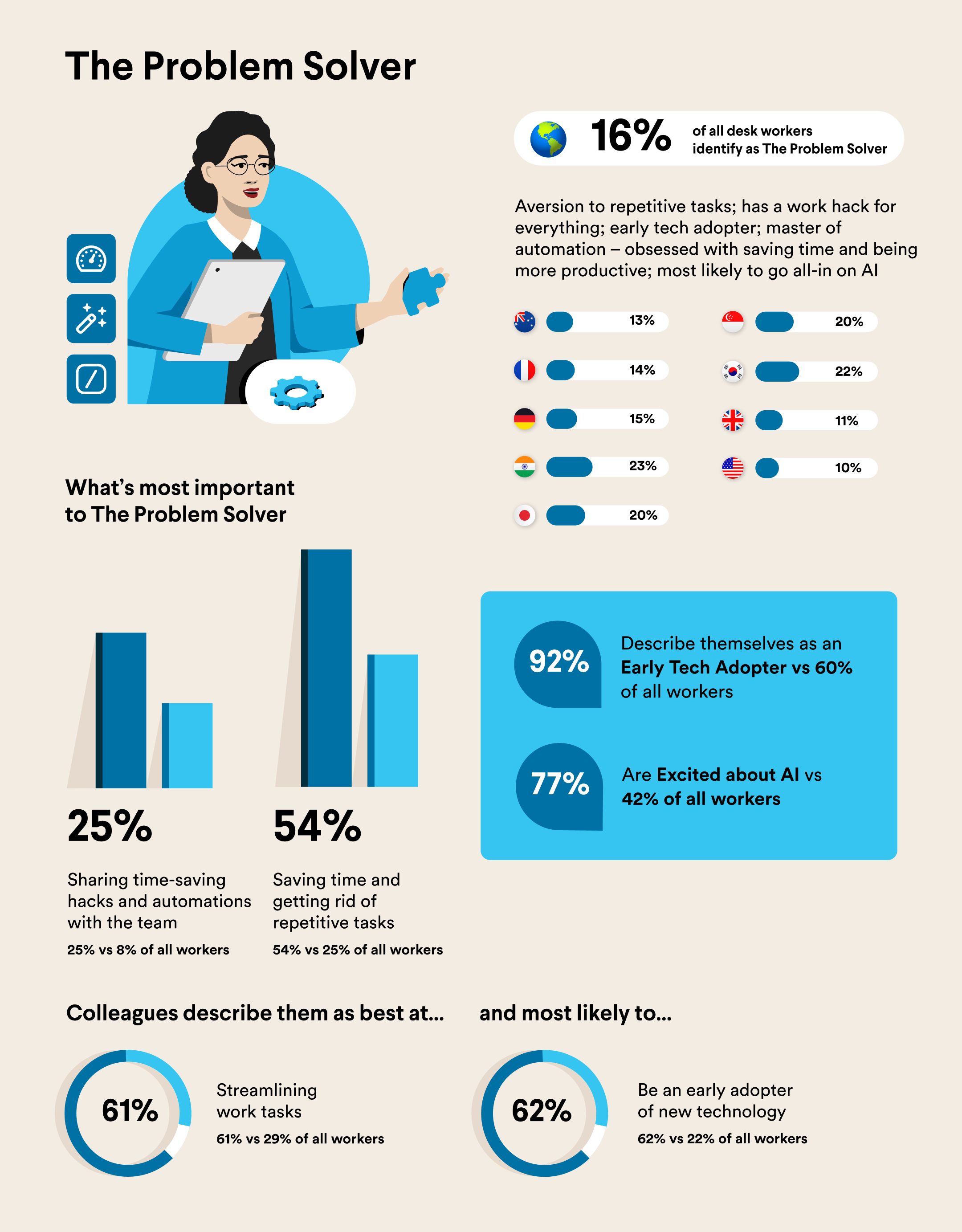Here’s why it’s important not to blindly automate everything

Recent revelations that the likes of Bank of Queensland and SA Power Networks are doubling down on AI-driven business process automation (BPA) reflect the surge of interest that has rapidly pushed automation to the top of CIOs’ priority lists. The employees best poised to make the most of AI and automation technology, however, may be hard to come by.

To build momentum with BPA, employers need people who are focused on continuous improvement, who are early adopters of technology and can maximise time saving and productivity by using tech to assist with repetitive tasks.
However, these so-called Problem Solvers make up only 13% of Australian desk workers, according to a recent global survey of 15,492 desk workers by productivity platform Slack and market research firm YouGov.
Aiming to better understand the diversity of traits in contemporary workplaces, the research identified five distinct workplace personas, with Problem Solvers working alongside ‘Detectives’, ‘Networkers’, ‘Road Warriors’, and ‘Expressionists’ that run the gamut of individual working styles and information processing preferences.
The Problem Solver loves nothing more than finding and sharing time-saving productivity hacks that help them eradicate repetitive tasks, and – with 77% excited about AI, compared with just 42% of all workers – they’re seen as early tech adopters who are known within their companies as being the best at streamlining work tasks.
That puts them front and centre of efforts to turn increasingly capable, well-integrated AI engines into business automation tools – a trend that, IDC research manager for AI and automation research Raghunanadhan Kuppuswamy recently pointed out, has driven businesses to realise that “utilising cutting-edge technology is not only a strategic necessity but also a crucial factor in achieving long-term success [and] future proofing their business operations.”
With IDC forecasting the worldwide AI software market will grow by 31.4% annually through 2027, the Problem Solver’s personality traits are likely to become hugely sought after within project teams in which the majority of members identify with other personas.
The Problem Solver’s predisposition for lateral thinking and frequent vocal advocacy for technology-driven improvement, Slack APAC technology evangelist Derek Laney believes, will make them the ones that team members rely on to make work better for the collective.
“We think about Problem Solvers as the continuous improvement officer,” he told iTnews. “They’re continuously feeling that nothing in the organisation moves fast enough, and they’re the kind of person who, five minutes into the meeting, says ‘this meeting could have just been a Slack message’.”
“They constantly want to improve everything, and you need that person in the mix – someone who is constantly challenging and saying ‘how can we do this differently?’”
As increasingly process-aware and industry-specific AI tools produce ever more-meaningful analysis and process recommendations, Problem Solvers are likely to lead the charge to embrace AI’s ability to rapidly analyse subject matter expertise to identify existing inefficiencies, then generate suggestions for improvement and guide process improvements.
“When it comes to AI, you’re going to need to make hard choices about whether to automate something or keep doing it as part of the fabric and culture,” Laney said, warning that many employees won’t necessarily agree with managers’ assumptions that workers want AI to take over the most routine parts of their jobs.
Many automation initiatives target “dopamine driving functions that may be low value to the organisation but high value to the employee,” Laney said.
“They get a sense of satisfaction from doing this function – and when [IT] say they’re going to automate those and their job is now going to comprise of these other things they don’t really like doing, that’s a real risk.”
“We need to consider people’s strengths, and how we let them lean into those things.”
It’s all about relAItionships
With the survey finding that a third of Australian workers are unfamiliar with their company’s plans to use AI for automation, getting broad support for a human-centric approach to AI may be frustrating to tech-focused Problem Solvers – 43% of whom said they are highly likely to seek out opportunities to use AI in the future and just 24% of whom said they are worried about AI.
That’s far less than the 80% of their colleagues that still have worries about AI – hinting at likely conflict within teams as Problem Solvers push for automation and other personas push back.
A productivity platform like Slack can prove instrumental in normalising other personas’ perceptions of the value technology can deliver in the way we work – whether that be AI and automation or collaborative tools.
Different workplace personas will be drawn to different tools, such as collaborative features like huddles, clips, canvas and Slack Connect, information services like Slack Atlas, and business process tools, such as Workflow Builder alongside over 2,600 app integrations.
Mastering collaboration tools is crucial given that 45% of workers are not co-located with their team, meaning that these newer, digital-first ways of working have become the glue that keeps hybrid project teams together.
“As we build relationships with each other, we gain more insights,” Laney explained.
“It’s the relationship component that gives us intelligence – and it’s about building a sense of belonging and connection, so that when we go back to our jobs, we have capital built up and a sense of understanding that our brains are in sync.”
Maintaining asynchronous problem-solving capabilities will help maintain the human aspect of business change – and, Laney says, ensure that businesses don’t blindly traipse past the “tipping point at which automation is going to be less successful.” A recent study of computer vision and job displacement by researchers at MIT suggests that this technology was only capable of automating tasks economically to account for 1.6% of workers’ wages.
“Multiple approaches to problems are more productive than trying to build a cyborg organisation of the same types of people,” he explained.
“If we look at all of these different personas and consider how they relate to the people in our own organisations, it’s easy to see the critical strengths that are uniquely human in a lot of these things.”
To learn more about how Slack helps Problem Solvers advocate for continuous improvement, click here.






 " title="
" title="